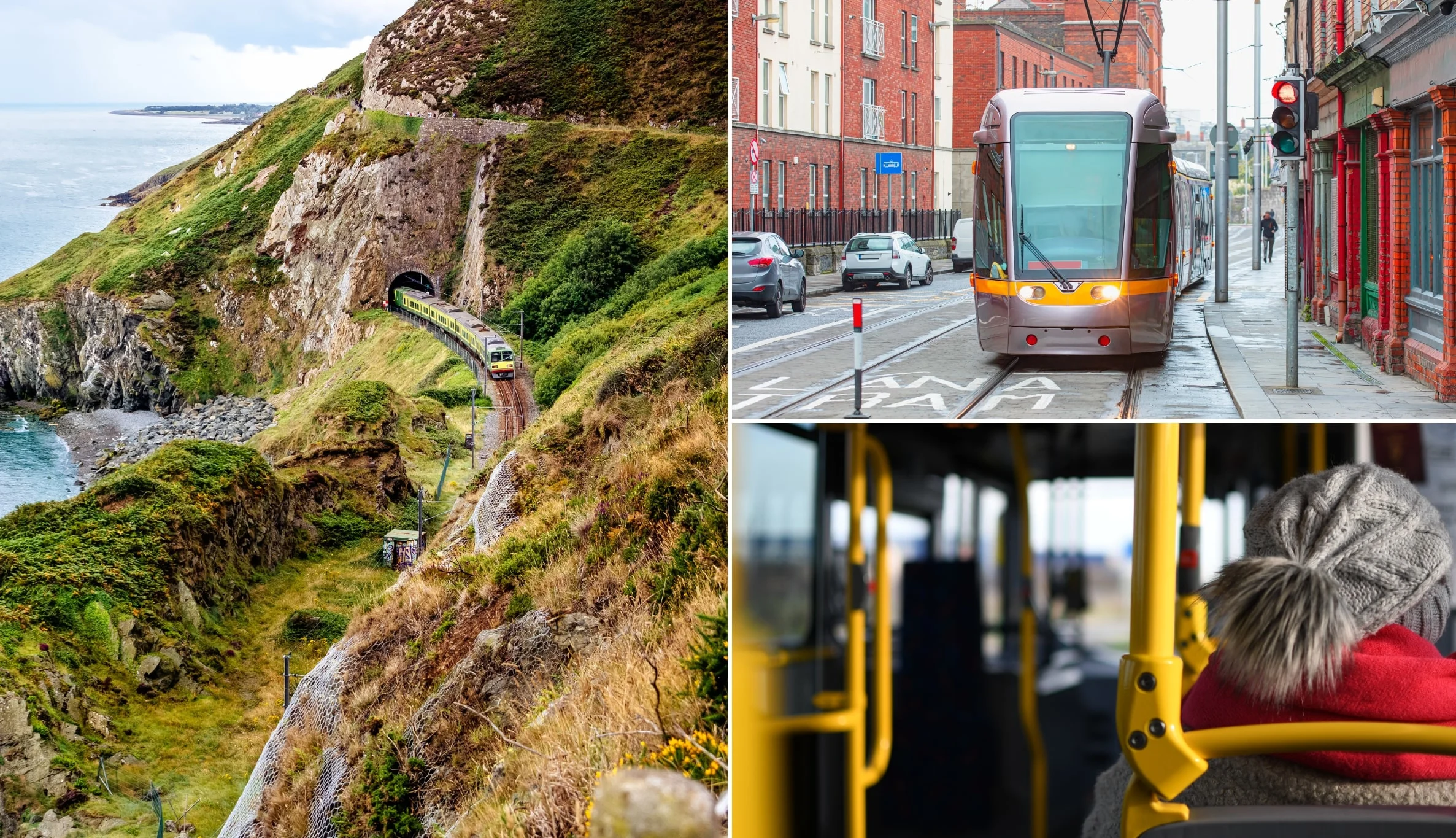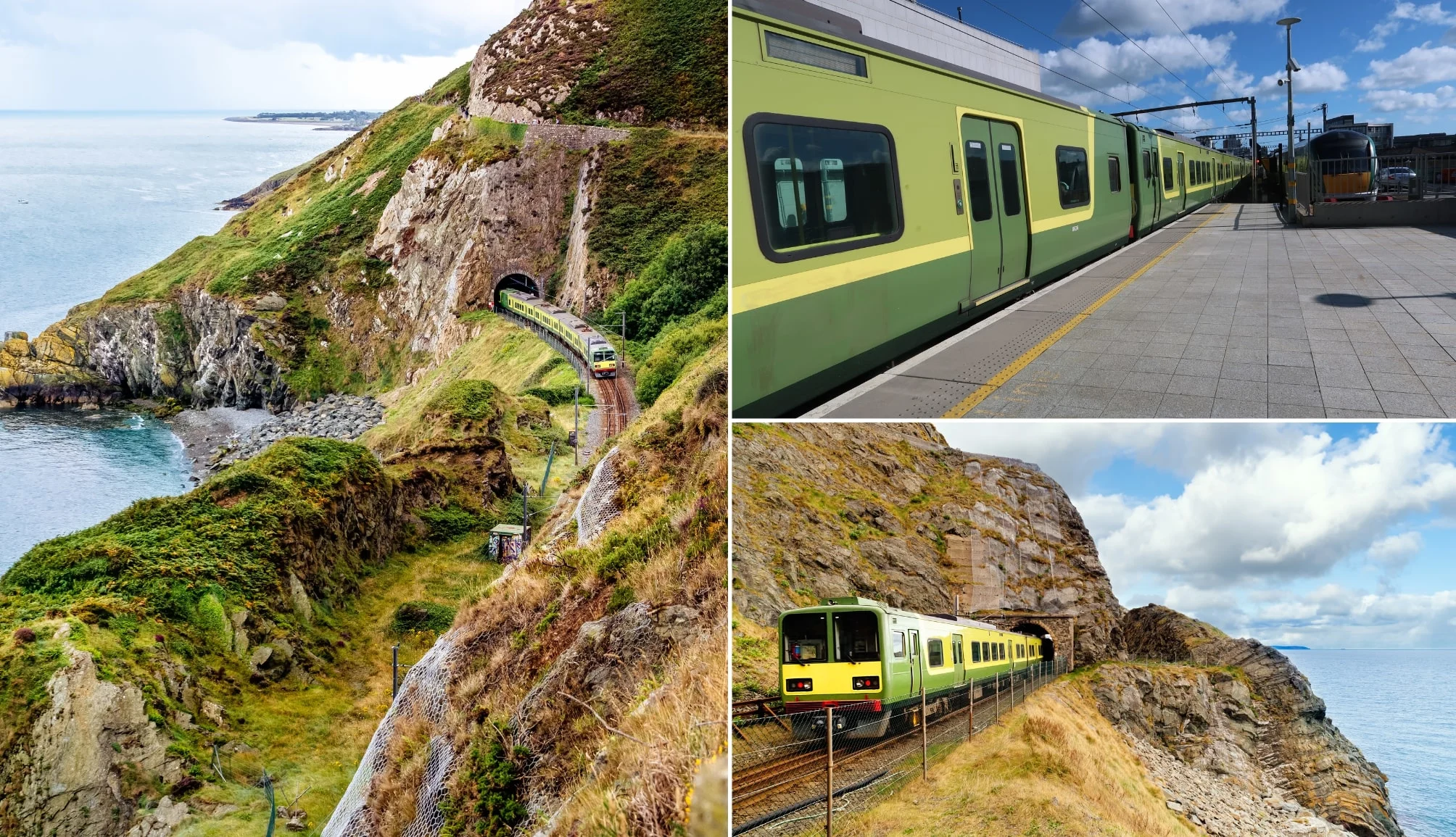Navigating public transportation in Ireland is easy, once you’ve wrapped your head around the ins and outs of it.
In a nutshell, there’s trains, trams (Dublin only!) and buses in Ireland.
This sounds straightforward, but getting around Ireland without a car can be confusing, especially when you don’t know the lay of the land.
In this guide, you’ll find everything you need to know to master public transportation in Ireland on your road trip!
Some quick need-to-knows about public transportation in Ireland

Take 20 seconds to read the points below as they’ll get you up-to-speed on public transportation in Ireland quickly:
1. There are trains, trams and buses
Trains, trams and buses will be your main form of public transport during a trip to Ireland. A combination of all of these can be found in Dublin, while outside the capital their availability will depend on where you are. Domestic flights within Ireland exist, too, (Dublin to Kerry, for example).
2. There’s pros and cons
The good thing about public transport is that it’s much cheaper than renting a car in Ireland and it also makes getting around Ireland easier in towns and cities. However, seeing some of Ireland’s greatest rural sights is made infinitely harder without a car. The spectacular county of Donegal, for example, has no train network and a limited bus network.
3. Book in advance where possible
If you’re planning a trip to Ireland, then booking public transport in advance is a good idea for several reasons. Not only will you get better value for money with cheaper advance ticket fares, it also means guaranteeing a seat on a train or an intercounty bus. Leaving it until the last minute is risky, so book ahead if possible.
4. Use one of our public transport itineraries
Need more inspiration? Check out one of our Irish public transport itineraries where we’ve crafted a range of unique schedules that range from three days to three weeks. They’ve been made exclusively for travellers planning to use buses and trains and are full of detail.
Trains in Ireland

Using Trains in Ireland is a great way to get from one side of the country to the other with ease.
They’re comfortable, generally reliable and you’ll find stations in many of the larger towns in Ireland.
1. Republic of Ireland and Northern Ireland trains
Trains in the Republic of Ireland are run by Iarnród Éireann (Irish Rail), while up in Northern Ireland trains are run by Translink.
Most routes in the Republic fan out in multiple directions from Dublin to several corners of the country, including Cork and Galway. In Northern Ireland, suburban routes run from Belfast out to the likes of Derry and Portrush.
The Enterprise route between Dublin Connolly and Belfast Lanyon Place runs between Ireland’s two largest cities and this quick and efficient train takes around 2.5 hours. It’s also 2.5 hours by train out to Cork and Galway.
2. Main train stations in Ireland
Dublin’s four main railway stations — Connolly, Pearse, Heuston and Tara Street — account for a third of all train passengers in Ireland (not surprising considering almost 30% of the country live within Dublin’s boundaries).
In Northern Ireland, Belfast Lanyon Place and Derry are two of the busiest stations (especially after the hourly service between the two started in 2018).
Of the other major cities in Ireland, Cork Kent station has the highest annual passenger numbers with around 2.3 million, followed by Galway Ceannt station with around 1.0 million, Limerick Colbert station with around 750,000 and Waterford Plunkett station with around 275,000.
3. Where and how to buy tickets
Buying tickets to travel on the trains in Ireland can be done either online or in person at the station (check the ticket office opening times for more rural or quieter stations).
Tickets for travel in the Republic of Ireland can be bought online from Irish Rail’s website, while in Northern Ireland they are similarly available at Translink’s website.
Buying online means you can purchase train tickets in advance from another country and they will often be cheaper too.
Buses in Ireland

A lot of people planning their Irish road trip underestimate the buses in Ireland. Yes, they’re few and far between in some counties, but many have a reliable service.
There’s a couple of need-to-knows about the buses in Ireland as there are lots of different providers.
1. ‘Main’ providers and smaller companies
Like the rail network, there are two main providers in the Republic of Ireland and Northern Ireland. Bus Éireann in the Republic of Ireland and Translink in Northern Ireland run coaches around the country regularly and for reasonable prices.
There are lots of other smaller private providers, however, and they can be useful if you’re looking for a more specific itinerary. So if you’d like a trip with a particular theme (golf, castles, etc) then they might be the way to go.
2. Money savers
Want to save a bit of cash on your travels? Dublin and Northern Ireland offer deals on certain bus services.
The Leap Visitor Card is a prepaid pass allowing travel on all Dublin Bus and Airlink 747 buses, as well as Dublin’s LUAS and DART network for 72 hours from its first use.
Like the Leap Card, the iLink smartcard in Northern Ireland gives you unlimited daily, weekly, and monthly bus and rail travel, and is available for Metro, NI Railways and Ulsterbus services within five zones.
3. Where and how to buy tickets
Similar to the rail network, buying tickets to travel on Ireland’s buses can be done either online or in person at the stations (and like the trains, we recommend online!).
Hop on to the Bus Éireann site to find tickets for bus travel in the Republic of Ireland or head to Translink for Northern Irish bus tickets.
Booking tickets in advance for some public transportation in Ireland makes it easier plan your journey properly, so get ahead of the crowd by doing just that.
The LUAS in Dublin

Public transportation in Ireland would be improved massively if there was a more robust tram service in place.
However, there’s currently only one tram operating in the country, and that’s the Luas in Dublin.
1. How it works
The LUAS is a two-line tram system in Dublin that runs east to west (Red Line) and north to south (Green Line) and has covered the Irish capital since 2004.
As of 2017, the two lines intersect in the city centre. In total, the network boasts 67 stations and 42.5 kilometres (26.4 mi) of track.
Trams are regular and don’t run from a set timetable. They operate from 05:30 to 00:30 Monday to Friday. Weekends are a little different when Saturday services run from 06:30 to 00:30, while on Sundays they’re only from 07:00 to 23:30.
2. The main lines and stops
There’s two main lines and to be fair to them they can take you around the city with ease.
The Red Line
Running from The Point in Dublin’s Docklands area out to Tallaght (along with a fork to Citywest and Saggart), the Red Line tram has 32 stations. It also connects with Dublin’s two busiest train stations, Connolly and Heuston.
The Green Line
Running from Broombridge north of the river down to Brides Glen/Sandyford near the Wicklow border, the Green Line tram has 35 stations. The Green Line stops at some of Dublin’s popular tourist spots including O’Connell Street, Trinity College and St Stephen’s Green.
3. Tickets and money savers
Ticket machines are located at every station and single or return tickets must be bought there. They can’t be bought online or on the tram itself (you risk a €100 fine if you’re caught by an inspector onboard without a valid ticket).
The Leap Card was mentioned a little earlier in this article and you can use it on the LUAS too. Having unlimited travel on the LUAS for a long weekend (at only €16.00) is super handy and is a great money and time saver.
FAQs about getting around Ireland via public transport
We get an awful lot of enquires from people planning a trip to Ireland asking whether is possible to get around without a car.
It 100% is once you plan your Ireland itinerary with care. Just keep in mind that public transportation in Ireland is poor in many remote parts of the country. Here are some FAQs we receive.
Is there good public transport in Ireland?
Public Transportation in Ireland is hit and miss. There’s trains, buses and Dublin has the Luas (tram) but when you step off-the-beaten-path services are heavily reduced.
Can you get around Ireland using public transport?
You can, but you need to plan carefully. At the top of this guide, you’ll find a link to our public transport road trip guides which use only buses and trains.

